Milking 300 cows, Landy brothers Michael and Tom rely heavily on the use of the farm telehandler on a daily basis. After clocking up in excess of 11,000 hours on their 2013 Manitou 735-120, the brothers were in the market for an upgrade.

The handler has a lift capacity of 5,000kg to its maximum lift height of 7.8m.
After considering the option of a pivot-steer or a wheel loader over a telehandler, the duo ruled out the idea on lifting height and stability reasons. Pushing up 550 acres of wagon silage on the pit annually, the brothers explained that they required a telehandler with significant weight and horsepower, while being compact enough to work around the farmyard on a daily basis.

The handler has a lift capacity of 5,000kg to its maximum lift height of 7.8m.
A lot of time was put into looking at and considering all options on the market. The biggest problem encountered was that most manufacturers didn’t offer the weight and horsepower in an agricultural telehandler which the Landys were after.
In the end, the brothers identified and travelled to look at three units, a JCB TM420, a Deici 6.90 and the Merlo TF50.8. Michael explained that the Merlo had the greatest power and weight in a compact unit. 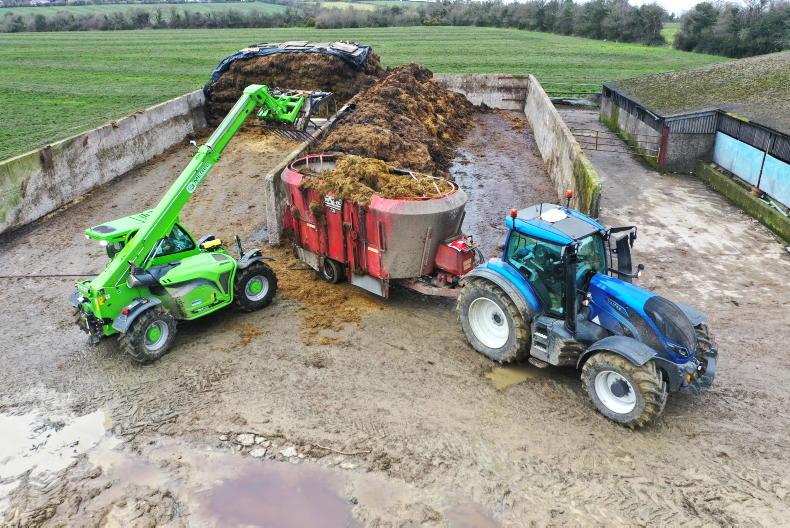
The TF50.8 is equipped with Merlo’s in-house designed CVTronic continuous variable transmission.
Engine
Since taking delivery of the TF50.8 last September, the brothers have clocked up over 520 hours. They have been more than happy with most aspects of the machine’s performance, especially from a power perspective.

Michael was very impressed with accessibility to the engine and all major components once the bonnet was lifted.
The TF50.8 is powered by a Fiat powertrain technologies (FPT) engine. This four-pot locomotive churns out a sizeable 170hp. The brothers noted that the Merlo is a very lively machine, with loads of get up and go.
Comfort, cab layout and visibility were some of the Landy brothers' favourites of the newly developed Merlo cab.
The handler has a 140l fuel tank which sits beside an 18l AdBlue tank. Michael noted that, to date, the machine is averaging approximately three tanks of diesel to one tank of AdBlue. He added that the machine would use the 140l of diesel in a long day, and would need topping up again before the day was out.
The joystick controls the FNR shuttle (forward/neutral/reverse), all boom movements and the auxiliary controls.
Michael was very impressed with accessibility to the engine and all major components once the bonnet was lifted. This was especially important to the brothers, as they carry out the majority of their own maintenance works. 
The TF50.8 is rated to pull a significant 21t.
Transmission
The TF50.8 is equipped with Merlo’s in-house-designed CVTronic continuous variable transmission. The CVTronic is hydrostatic and allows for continuous acceleration from 0km/h to 40km/h.
The transmission features two axial piston hydrostatic motors powered by the electronically controlled hydraulic pump. At low working speeds, they function together to provide maximum torque.
During transport, the second hydrostatic motor is automatically disengaged from the control system and the oil from the pump powers the main hydrostatic motor that pushes the turbocharger to maximum speed.
The brothers noted this extra capacity is noticeable when towing loaded trailers.
The unit can be operated in automatic (0-40km/h) or snail (0-10km/h) modes. Once at top speed, the rpm will automatically cut back to help save fuel. 
Michael was very impressed with accessibility to the engine and all major components once the bonnet was lifted.
Towing capacity
One of the big attractions to the Merlo for the Landy brothers was its pick-up hitch and high-rated towing capacity. The TF50.8 is rated to pull a significant 21t.
When I first pulled into the Landys’ out-farm, they were loading up 28 bales of straw on a tandem-axle trailer before towing it up the road at its ease.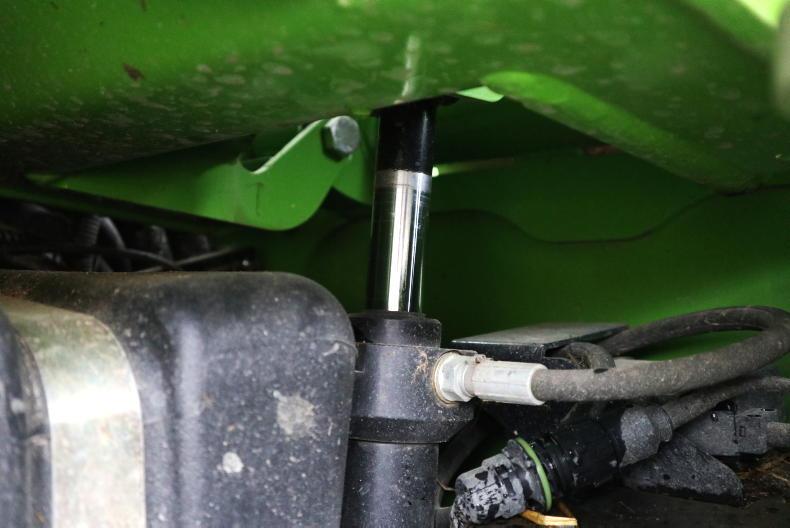
The brothers opted for the additional hydro pneumatic cab suspension system.
Michael explained: “The pick-up hitch on the telehandler has meant that one of us can go with a trailer and do the same work in almost the same time, where traditionally two of us would have been needed to go with the telehandler and tractor. If all the tractors are tied up or coupled with an implement, we can easily use the telehandler for the same work.
“One day Tom pulled a fully loaded tandem-axle cattle trailer (approximately 17t) to drop cattle over an hour away when the other tractors were tied up.”
The pickup hitch comes with up to four hydraulic connections, a seven-pin plug for lights and hydraulic trailer braking. 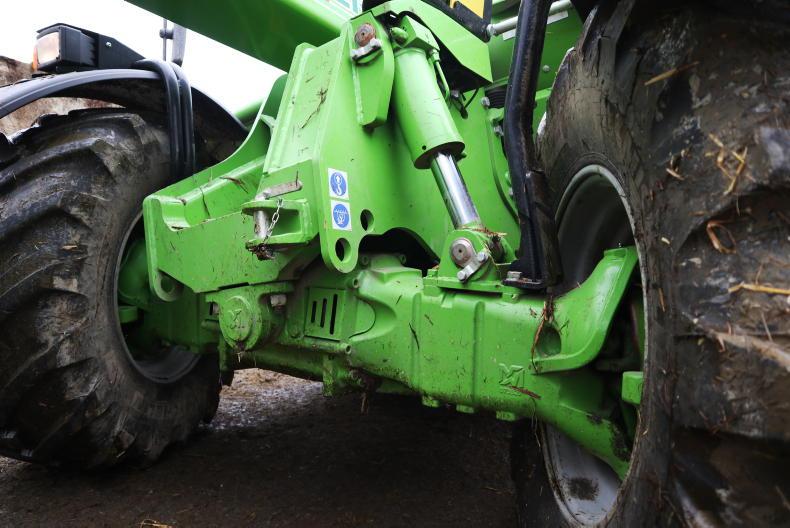
A tilting ram on the handler’s front axle allows it to level the headstock if working in tricky ground conditions.
On the pit
Although the brothers only got to push up the last 45 acres of third-cut silage with the then new handler, they got a good initial feel for its capability.
Tom said they operated it by setting the rpm and hydraulic flow rate independently of forward speed, which was controlled on the accelerator pedal. This gave them full hydraulic capacity at all times.
Alternatively, the inching pedal can be used for calibrated movements. They were very impressed with the handler’s ability to climb while flicking grass on the move. This was down to its high hydraulic capacity of 150l/min. The fully enclosed underbelly and high ground clearance also stood out.

Michael noted that the only downside to the axles was the positioning of the steering rams to the bottom of the axles where they are slightly exposed
The loader is shod on Michelin 550/70R24 tyres. The Landys traditionally fitted duals to their Manitou when working on clamp duties. However, this wasn’t an option on the Merlo. As a result, the brothers are currently looking at purchasing a new set of 620s or 700s solely for pit work.

Weigh cells are built into the boom and all weights are they displayed on a screen in the cab.
One thing that concerned them a little is the fact the mudguards don’t turn with the wheels. This means they have to keep a closer eye when working around pit walls and when cleaning out sheds. The hydraulic tank is positioned inside the rear left wheel. As the mudguards don’t swivel, it leaves accessing the bung a little difficult.
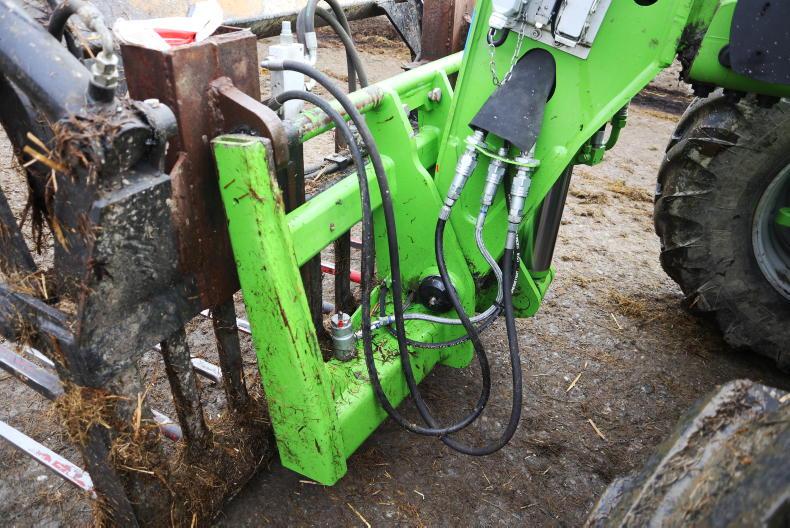
As soon as you take your hand off the switch, the pressure on the hoses is completely released.
Build quality
The heavy-duty build of the telehandler and especially the axles was a standout feature for the Kilkenny brothers. The planetary axles are designed in-house by Merlo. These HD machines are equipped with four dry disc brakes. The parking brake is automatically engaged when the engine is switched off.

Tom (left) and Michael (right) Landy.
Michael noted that the only downside to the axles was the positioning of the steering rams to the bottom of the axles where they are slightly exposed, compared with the Manitou where they were positioned on top. 
“Halogens are a thing of the past. The telehandler should come with LEDs as standard", said Tom.
The heavy-duty build and weight contributes to good stability, which is required when reaching out to the handler’s maximum lift height of 7.8m.
When changing hoses to the auxiliaries, Michael noted that as soon as you take your hand off the switch, the pressure on the hoses is completely released, which is a very welcome feature.
However, to activate the quick hitch, the auxiliaries need to be plugged out and the quick-hitch hose plugged in. Michael said this was a bit of a nuisance and a diverter valve or a second auxiliary should have been fitted.
A tilting ram on the handler’s front axle allows it to level the headstock if working in tricky ground conditions. 
The loader is shod on Michelin 550/70R24 tyres.
Cab
Comfort, cab layout and visibility were some of the Landy brothers’ favourites of the newly developed Merlo cab.
Tom explained: “The low positioning of the boom and the large cab means that visibility all round is very good. The machine is very comfortable. One small issue for taller people is that the high positioning of the Grammar seat means you could hit your head off the roof if you hit a rut on the road.” 
LED worklights were ordered.
Tom was also quick to point out the comfort of working in the air conditioned cab during warm dusty summer days.
The brothers opted for the additional cab suspension system. This hydro pneumatic suspension system can be activated by the operator. They also opted for the hydro pneumatic boom suspension. This automatically deactivates under 3km/h for precision when loading.
Both were quick to note that the handler was every bit as comfortable as a new Valtra T234 which was sitting beside it in the yard. 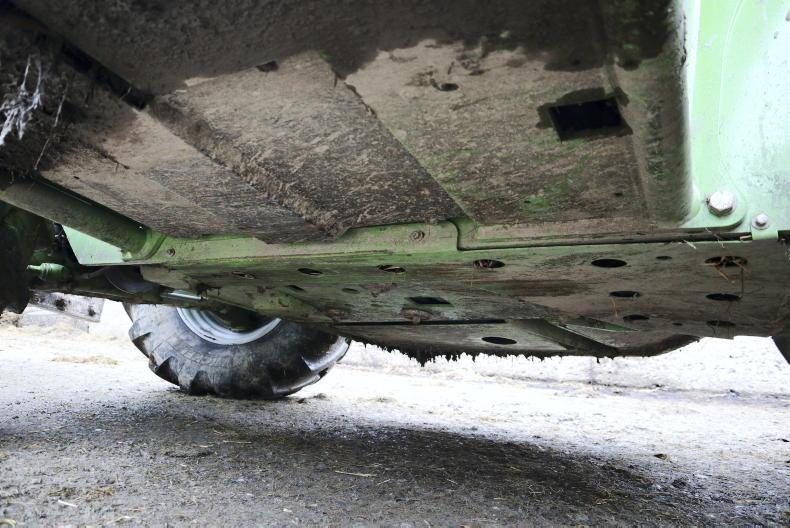
The enclosed underbelly is well protected.
They were very fond of the control layout, especially the shape of the new joystick. The joystick controls the FNR shuttle (forward/neutral/reverse), all boom movements and the auxiliary controls.
Weigh cells are built into the boom as standard. All weights are then displayed on a screen in the cab. This can be set to record all weight lifted within a desired time frame if needed.
Optional LED work lights were ordered, but Tom noted that LED headlights weren’t available. The brothers both agreed that the halogens road lights were quite poor and that LEDs would have been much better.
“Halogens are a thing of the past. The telehandler should come with LEDs as standard. It could even do with a few more work lights to the side of the machine, especially if at silage in the dark. All in all, we really like the cab. It’s even down to the simple things.
“Our previous Manitou door could only open back half way. The door on the Merlo opens all the way back and can be latched to the frame of the cab. Similarly, it can be spilt into half, with the option of leaving the half door open with the other half safely latched back,” said Tom.
The Landys are intending on keeping the handler until it surpasses 10,000 hours, before considering upgrading again.
Likes
Very comfortable.Lively engine, with ample power.Weight and stability.Dislikes
Mudguards don’t turn with the wheels.Hydraulic tank is difficult to access.Quick hitch should have a diverter to use auxiliaries.Specs
Engine: four cylinder, 170hp FPT engine.Transmission: ‘CVTronic’ continuous variable transmission.Hydraulics: 150 l/min.Lift capacity at maximum height: 5,000kg.Max lift height: 7.8m.Unladen weight: 9,650kg.Fuel tank: 140 litres. AdBlue tank: 18 litres.Tyres: Michelin 550/70R24.Starting price: €95,000 plus VAT.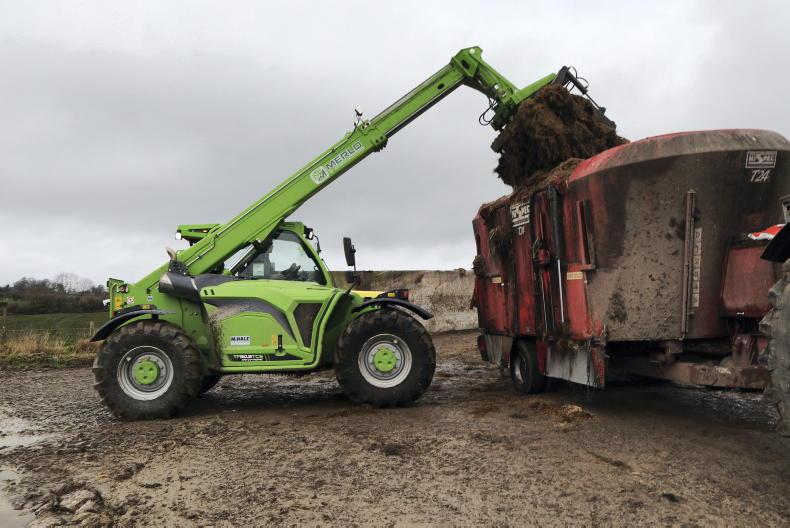
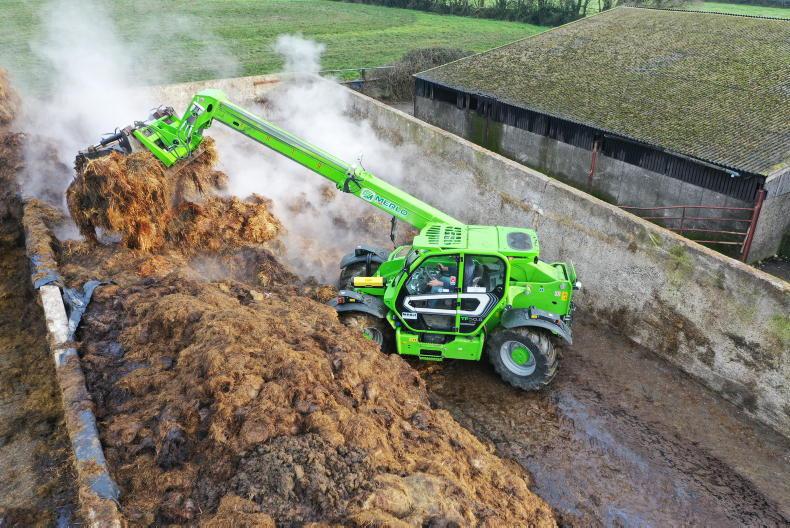
Milking 300 cows, Landy brothers Michael and Tom rely heavily on the use of the farm telehandler on a daily basis. After clocking up in excess of 11,000 hours on their 2013 Manitou 735-120, the brothers were in the market for an upgrade.

The handler has a lift capacity of 5,000kg to its maximum lift height of 7.8m.
After considering the option of a pivot-steer or a wheel loader over a telehandler, the duo ruled out the idea on lifting height and stability reasons. Pushing up 550 acres of wagon silage on the pit annually, the brothers explained that they required a telehandler with significant weight and horsepower, while being compact enough to work around the farmyard on a daily basis.

The handler has a lift capacity of 5,000kg to its maximum lift height of 7.8m.
A lot of time was put into looking at and considering all options on the market. The biggest problem encountered was that most manufacturers didn’t offer the weight and horsepower in an agricultural telehandler which the Landys were after.
In the end, the brothers identified and travelled to look at three units, a JCB TM420, a Deici 6.90 and the Merlo TF50.8. Michael explained that the Merlo had the greatest power and weight in a compact unit. 
The TF50.8 is equipped with Merlo’s in-house designed CVTronic continuous variable transmission.
Engine
Since taking delivery of the TF50.8 last September, the brothers have clocked up over 520 hours. They have been more than happy with most aspects of the machine’s performance, especially from a power perspective.

Michael was very impressed with accessibility to the engine and all major components once the bonnet was lifted.
The TF50.8 is powered by a Fiat powertrain technologies (FPT) engine. This four-pot locomotive churns out a sizeable 170hp. The brothers noted that the Merlo is a very lively machine, with loads of get up and go.
Comfort, cab layout and visibility were some of the Landy brothers' favourites of the newly developed Merlo cab.
The handler has a 140l fuel tank which sits beside an 18l AdBlue tank. Michael noted that, to date, the machine is averaging approximately three tanks of diesel to one tank of AdBlue. He added that the machine would use the 140l of diesel in a long day, and would need topping up again before the day was out.
The joystick controls the FNR shuttle (forward/neutral/reverse), all boom movements and the auxiliary controls.
Michael was very impressed with accessibility to the engine and all major components once the bonnet was lifted. This was especially important to the brothers, as they carry out the majority of their own maintenance works. 
The TF50.8 is rated to pull a significant 21t.
Transmission
The TF50.8 is equipped with Merlo’s in-house-designed CVTronic continuous variable transmission. The CVTronic is hydrostatic and allows for continuous acceleration from 0km/h to 40km/h.
The transmission features two axial piston hydrostatic motors powered by the electronically controlled hydraulic pump. At low working speeds, they function together to provide maximum torque.
During transport, the second hydrostatic motor is automatically disengaged from the control system and the oil from the pump powers the main hydrostatic motor that pushes the turbocharger to maximum speed.
The brothers noted this extra capacity is noticeable when towing loaded trailers.
The unit can be operated in automatic (0-40km/h) or snail (0-10km/h) modes. Once at top speed, the rpm will automatically cut back to help save fuel. 
Michael was very impressed with accessibility to the engine and all major components once the bonnet was lifted.
Towing capacity
One of the big attractions to the Merlo for the Landy brothers was its pick-up hitch and high-rated towing capacity. The TF50.8 is rated to pull a significant 21t.
When I first pulled into the Landys’ out-farm, they were loading up 28 bales of straw on a tandem-axle trailer before towing it up the road at its ease.
The brothers opted for the additional hydro pneumatic cab suspension system.
Michael explained: “The pick-up hitch on the telehandler has meant that one of us can go with a trailer and do the same work in almost the same time, where traditionally two of us would have been needed to go with the telehandler and tractor. If all the tractors are tied up or coupled with an implement, we can easily use the telehandler for the same work.
“One day Tom pulled a fully loaded tandem-axle cattle trailer (approximately 17t) to drop cattle over an hour away when the other tractors were tied up.”
The pickup hitch comes with up to four hydraulic connections, a seven-pin plug for lights and hydraulic trailer braking. 
A tilting ram on the handler’s front axle allows it to level the headstock if working in tricky ground conditions.
On the pit
Although the brothers only got to push up the last 45 acres of third-cut silage with the then new handler, they got a good initial feel for its capability.
Tom said they operated it by setting the rpm and hydraulic flow rate independently of forward speed, which was controlled on the accelerator pedal. This gave them full hydraulic capacity at all times.
Alternatively, the inching pedal can be used for calibrated movements. They were very impressed with the handler’s ability to climb while flicking grass on the move. This was down to its high hydraulic capacity of 150l/min. The fully enclosed underbelly and high ground clearance also stood out.

Michael noted that the only downside to the axles was the positioning of the steering rams to the bottom of the axles where they are slightly exposed
The loader is shod on Michelin 550/70R24 tyres. The Landys traditionally fitted duals to their Manitou when working on clamp duties. However, this wasn’t an option on the Merlo. As a result, the brothers are currently looking at purchasing a new set of 620s or 700s solely for pit work.

Weigh cells are built into the boom and all weights are they displayed on a screen in the cab.
One thing that concerned them a little is the fact the mudguards don’t turn with the wheels. This means they have to keep a closer eye when working around pit walls and when cleaning out sheds. The hydraulic tank is positioned inside the rear left wheel. As the mudguards don’t swivel, it leaves accessing the bung a little difficult.

As soon as you take your hand off the switch, the pressure on the hoses is completely released.
Build quality
The heavy-duty build of the telehandler and especially the axles was a standout feature for the Kilkenny brothers. The planetary axles are designed in-house by Merlo. These HD machines are equipped with four dry disc brakes. The parking brake is automatically engaged when the engine is switched off.

Tom (left) and Michael (right) Landy.
Michael noted that the only downside to the axles was the positioning of the steering rams to the bottom of the axles where they are slightly exposed, compared with the Manitou where they were positioned on top. 
“Halogens are a thing of the past. The telehandler should come with LEDs as standard", said Tom.
The heavy-duty build and weight contributes to good stability, which is required when reaching out to the handler’s maximum lift height of 7.8m.
When changing hoses to the auxiliaries, Michael noted that as soon as you take your hand off the switch, the pressure on the hoses is completely released, which is a very welcome feature.
However, to activate the quick hitch, the auxiliaries need to be plugged out and the quick-hitch hose plugged in. Michael said this was a bit of a nuisance and a diverter valve or a second auxiliary should have been fitted.
A tilting ram on the handler’s front axle allows it to level the headstock if working in tricky ground conditions. 
The loader is shod on Michelin 550/70R24 tyres.
Cab
Comfort, cab layout and visibility were some of the Landy brothers’ favourites of the newly developed Merlo cab.
Tom explained: “The low positioning of the boom and the large cab means that visibility all round is very good. The machine is very comfortable. One small issue for taller people is that the high positioning of the Grammar seat means you could hit your head off the roof if you hit a rut on the road.” 
LED worklights were ordered.
Tom was also quick to point out the comfort of working in the air conditioned cab during warm dusty summer days.
The brothers opted for the additional cab suspension system. This hydro pneumatic suspension system can be activated by the operator. They also opted for the hydro pneumatic boom suspension. This automatically deactivates under 3km/h for precision when loading.
Both were quick to note that the handler was every bit as comfortable as a new Valtra T234 which was sitting beside it in the yard. 
The enclosed underbelly is well protected.
They were very fond of the control layout, especially the shape of the new joystick. The joystick controls the FNR shuttle (forward/neutral/reverse), all boom movements and the auxiliary controls.
Weigh cells are built into the boom as standard. All weights are then displayed on a screen in the cab. This can be set to record all weight lifted within a desired time frame if needed.
Optional LED work lights were ordered, but Tom noted that LED headlights weren’t available. The brothers both agreed that the halogens road lights were quite poor and that LEDs would have been much better.
“Halogens are a thing of the past. The telehandler should come with LEDs as standard. It could even do with a few more work lights to the side of the machine, especially if at silage in the dark. All in all, we really like the cab. It’s even down to the simple things.
“Our previous Manitou door could only open back half way. The door on the Merlo opens all the way back and can be latched to the frame of the cab. Similarly, it can be spilt into half, with the option of leaving the half door open with the other half safely latched back,” said Tom.
The Landys are intending on keeping the handler until it surpasses 10,000 hours, before considering upgrading again.
Likes
Very comfortable.Lively engine, with ample power.Weight and stability.Dislikes
Mudguards don’t turn with the wheels.Hydraulic tank is difficult to access.Quick hitch should have a diverter to use auxiliaries.Specs
Engine: four cylinder, 170hp FPT engine.Transmission: ‘CVTronic’ continuous variable transmission.Hydraulics: 150 l/min.Lift capacity at maximum height: 5,000kg.Max lift height: 7.8m.Unladen weight: 9,650kg.Fuel tank: 140 litres. AdBlue tank: 18 litres.Tyres: Michelin 550/70R24.Starting price: €95,000 plus VAT.

























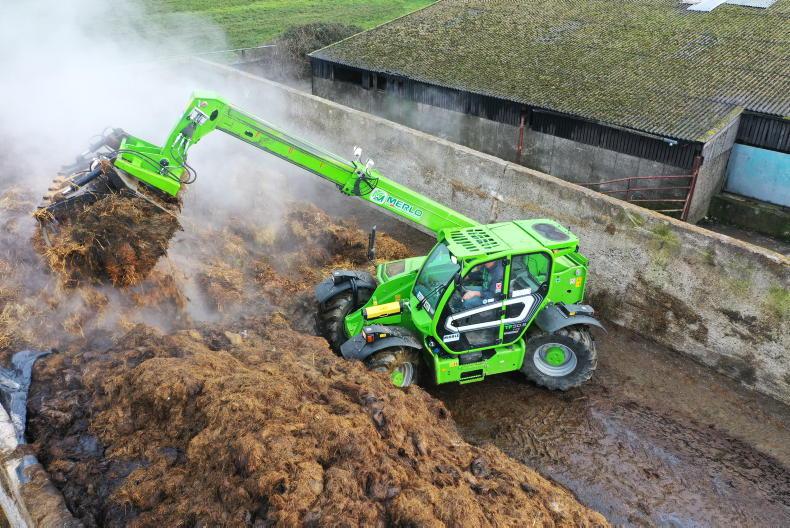


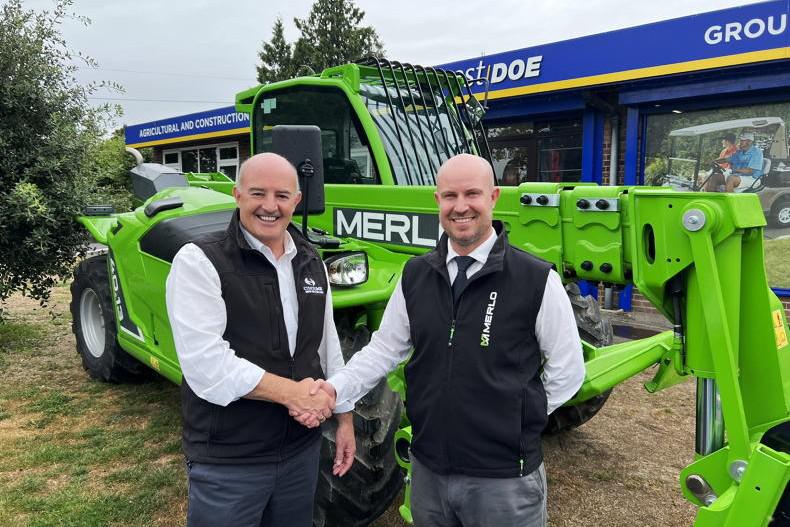

SHARING OPTIONS